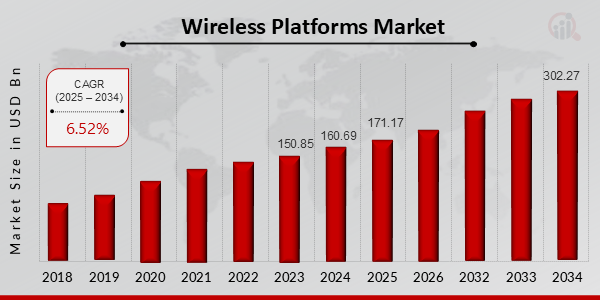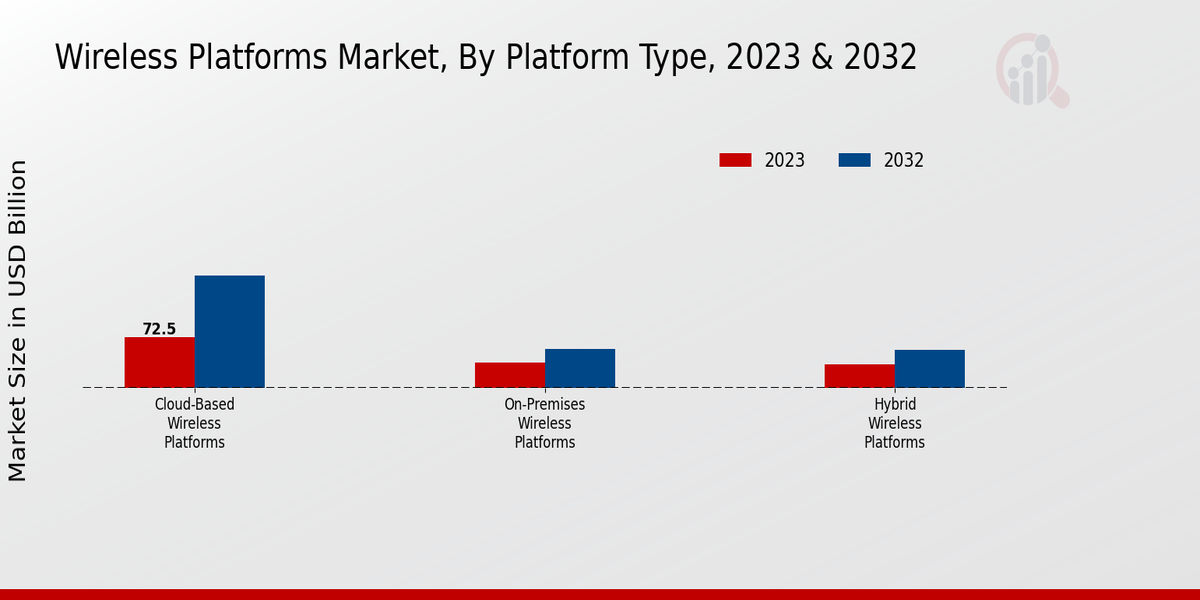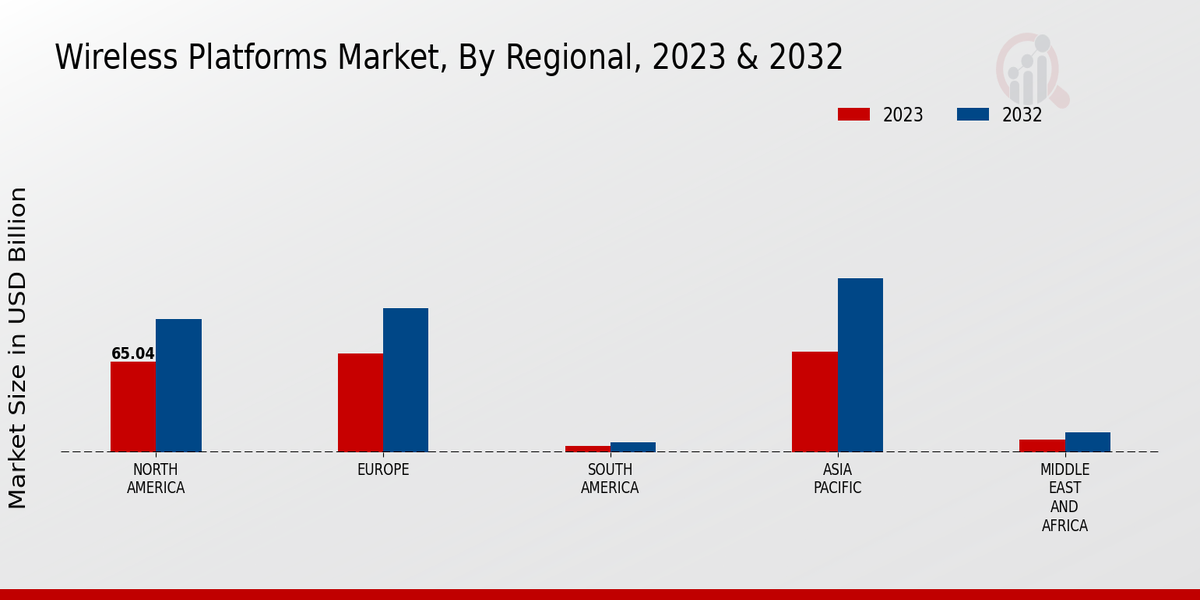Wireless Platforms Market Overview
Wireless Platforms Market is projected to grow from USD 171.17 Billion in 2025 to USD 302.27 Billion by 2034, exhibiting a compound annual growth rate (CAGR) of 6.52% during the forecast period (2025 - 2034). Additionally, the market size for Wireless Platforms Market was valued at USD 160.69 billion in 2024.
Key Wireless Platforms Market Trends Highlighted
The Wireless Platforms Market is responding to the increasing need for ease of communication and movement in a multitude of fields. Among the key driving factors are the increasing number of mobile devices, the introduction of the fifth generation of mobile networks, and the growing number of applications without wires.
Several factors offer opportunities in the market, including the growth of IoT devices or the availability and use of artificial intelligence in wireless platforms. In recent years, there has been an increasing trend towards more cloud-based wireless platforms, open-source software usage, and more network slicing.
In addition, wireless platform providers have been responding to such trends by developing mobile solutions for various industry verticals. For example, wireless platforms in the healthcare industry allow remote monitoring of patients, as well as telemedicine and mobile health services. In production, it allows for collecting data in real-time, updating machines before breakdowns and automating some functions. Wireless platform providers have the luxury of pursuing such opportunities and meeting the changing needs of the market in order to achieve more growth and innovations in the coming years.
Figure 1: Wireless Platforms Market Size, 2025-2034 (USD Billion)

Source: Primary Research, Secondary Research, MRFR Database and Analyst Review
Wireless Platforms Market Drivers
Rising Demand for Mobile Broadband Connectivity
The increasing adoption of smartphones, tablets, and other mobile devices is driving the demand for wireless broadband connectivity. As more people use their mobile devices to access the internet, stream videos, and download apps, the need for reliable and high-speed wireless networks is growing. This is a major factor contributing to the growth of the Wireless Platforms Market Industry.
Growth of the Internet of Things (IoT)
The Internet of Things is a system of interrelated computing devices, digital machines, and objects having the ability to transfer data or entities over a network without requiring human-to-human or human-to-computer interaction. An increase in the application of the IoT in various industries is expected to offer growth opportunities for wireless platforms. Wireless platforms are used for connecting and managing devices designed using the IoT. Thus, this may be one key factor that will drive the Wireless Platforms Market Industry.
Increasing Adoption of Cloud-Based Services
An increase in the adoption of cloud-based services is being observed. Businesses and consumers are moving their data and applications to the cloud; however, they will require wireless platforms to be able to access the cloud. This will also contribute to the increase in demand across the Wireless Platforms Market Industry.
Wireless Platforms Market Segment Insights
Wireless Platforms Market Platform Type Insights
The Platform Type segment of the Wireless Platforms Market holds significant importance in shaping the industry landscape. Cloud-Based Wireless Platforms, On-Premises Wireless Platforms, and Hybrid Wireless Platforms are the three prominent sub-segments within this segment. Cloud-Based Wireless Platforms have gained immense traction in recent years due to their cost-effectiveness, scalability, and flexibility.
The Wireless Platforms Market revenue generated by Cloud-Based Wireless Platforms is projected to reach $72.5 billion by 2027, expanding at a CAGR of 12.4%.This growth is attributed to the increasing adoption of cloud computing across various industries, particularly in developing regions. On-Premises Wireless Platforms, while still relevant in certain scenarios, have a more limited market share compared to their cloud-based counterparts. However, they offer greater control and security, making them suitable for organizations with stringent compliance requirements.
The Wireless Platforms Market data indicates that the On-Premises Wireless Platforms segment is estimated to account for $35.2 billion in revenue by 2027, growing at a CAGR of 5.6%.Hybrid Wireless Platforms, combining the advantages of both cloud-based and on-premises deployments, are gaining popularity as organizations seek to optimize their wireless infrastructure. The Wireless Platforms Market Statistics reveal that the Hybrid Wireless Platforms segment is poised to witness a significant growth rate, reaching $42.3 billion in revenue by 2027, expanding at a CAGR of 10.2%.
This growth is driven by the increasing demand for flexible and cost-efficient wireless solutions that can adapt to changing business needs. Overall, the Platform Type segment plays a crucial role in the Wireless Platforms Market industry.Cloud-Based Wireless Platforms' dominance, coupled with the growing adoption of Hybrid Wireless Platforms, is expected to shape the market growth trajectory over the coming years.

Source: Primary Research, Secondary Research, MRFR Database and Analyst Review
Wireless Platforms Market Deployment Model Insights
The deployment model segment of the Wireless Platforms Market is categorized into Public Cloud, Private Cloud, Software-as-a-Service (SaaS), and Platform-as-a-Service (PaaS). Among these, the Public Cloud segment is projected to hold the largest market share in 2023, owing to its cost-effectiveness and scalability. The SaaS segment is expected to witness the highest CAGR during the forecast period, driven by the growing adoption of cloud-based solutions. This growth is attributed to the increasing demand for wireless connectivity and the adoption of advanced technologies such as 5G and IoT.
Wireless Platforms Market Application Insights
The Wireless Platforms Market segmentation by Application is witnessing significant growth in various segments. The Wireless Device Management segment held a substantial market share in 2023 and is projected to maintain its dominance throughout the forecast period. The growing adoption of wireless devices in various industries, including healthcare, retail, and manufacturing, is driving the demand for efficient device management solutions.
The Network Monitoring and Troubleshooting segment is also expected to witness notable growth due to the increasing need for proactive network monitoring to ensure optimal performance and minimize downtime.The Security and Compliance segment is gaining traction as organizations prioritize data security and regulatory compliance. Wireless platforms offer advanced security features to protect against cyber threats and ensure compliance with industry standards.
The Policy Management segment is expected to grow steadily as businesses seek to manage and enforce policies across wireless devices and networks. The Mobile Application Development segment presents significant opportunities due to the surge in mobile app development and the need for platforms that support rapid and efficient app development.
Wireless Platforms Market End-User Industry Insights
The Wireless Platforms Market is segmented by End-User Industry into Telecommunications, Healthcare, Manufacturing, Transportation and Logistics, and Retail. Among these segments, Telecommunications is expected to hold the largest market share in 2023, accounting for around 28%. The Healthcare segment is projected to grow at the highest CAGR during the forecast period, owing to the increasing adoption of wireless technologies in healthcare applications.
Wireless Platforms Market Protocol Insights
The Wireless Platforms Market is expected to be driven by the increasing adoption of wireless technologies in various industries. The market is segmented by protocol, which includes Wi-Fi, Cellular (LTE, 5G), Bluetooth, Zigbee, and LoRaWAN. Wi-Fi is the most widely used wireless protocol, accounting for over 50% of the market share in 2023.
The growth of Wi-Fi is attributed to its high speed, reliability, and ease of use. Cellular (LTE, 5G) is another major protocol, which is expected to grow significantly in the coming years due to the increasing adoption of mobile devices and the rollout of 5G networks.Bluetooth is a short-range wireless protocol that is used for connecting devices such as smartphones, headphones, and speakers.
Zigbee is a low-power wireless protocol that is used for connecting devices in home automation and industrial applications. LoRaWAN is a long-range wireless protocol that is used for connecting devices in smart city and Internet of Things (IoT) applications. The Wireless Platforms Market is expected to grow at a CAGR of 6.52% from 2024 to 2032. The market is expected to be valued at USD 250.0 billion by 2032, up from USD 141.62 billion in 2023.The growth of the market is attributed to the increasing adoption of wireless technologies in various industries, including healthcare, retail, and manufacturing.
Wireless Platforms Market Regional Insights
The regional segment analysis of the Wireless Platforms Market offers insights into the market's performance across various geographical regions. North America is anticipated to dominate the market, driven by factors such as the presence of leading technology companies, high adoption of wireless technologies, and government initiatives supporting wireless infrastructure development.
Europe is expected to hold a significant share, owing to the presence of a large number of wireless operators and a favorable regulatory environment. APAC is projected to witness substantial growth, fueled by the rising demand for wireless services in emerging economies like India and China.South America and MEA are anticipated to experience steady growth, supported by increasing mobile penetration and government efforts to improve wireless connectivity. The Wireless Platforms Market in North America is valued at USD 65.04 billion in 2023 and is projected to reach USD 95.31 billion by 2032, exhibiting a CAGR of 4.5% during the forecast period. The market growth is attributed to the increasing adoption of wireless technologies, the growing number of connected devices, and the rising demand for high-speed internet connectivity.

Source: Primary Research, Secondary Research, MRFR Database and Analyst Review
Wireless Platforms Market Key Players And Competitive Insights
Major players in the Wireless Platforms Market industry are continuously investing in research and development to enhance their offerings and gain a competitive edge. Leading Wireless Platforms Market players are focused on developing innovative solutions that cater to the evolving needs of customers. The Wireless Platforms Market development is driven by the increasing adoption of cloud-based platforms, the growing popularity of mobile devices, and the need for real-time data access.
The Wireless Platforms Market Competitive Landscape is characterized by the presence of both established players and emerging startups.A leading company in the Wireless Platforms Market is Cisco Systems. Cisco offers a comprehensive suite of wireless platforms that enable enterprises and service providers to deliver secure, reliable, and scalable wireless networks.
The company's platforms are designed to support a wide range of applications, including voice, data, and video. Cisco has a strong global presence and a large customer base.A competitor company in the Wireless Platforms Market is Juniper Networks. Juniper offers a portfolio of wireless platforms that are designed to meet the needs of small, medium, and large enterprises. The company's platforms are known for their performance, reliability, and security. Juniper is focused on expanding its market share by investing in new technologies and expanding its geographic reach.
Key Companies in the Wireless Platforms Market Include
- Ribbon Communications
- Nokia
- Intel
- Ericsson
- NEC
- Oracle
- Mavenir
- Airspan Networks
- Cisco Systems
- CommScope
- Samsung Electronics
- Fujitsu
- Altiostar
- Huawei
- VMware
Wireless Platforms Market Industry Developments
The Wireless Platforms Market is projected to grow from USD 141.62 billion in 2023 to USD 250.0 billion by 2032, at a CAGR of 6.52% during the forecast period. Key factors driving this growth include increasing adoption of wireless technologies, rising demand for mobile broadband services, and growing popularity of connected devices. Recent news developments in the market includeIn February 2023, Qualcomm and Ericsson announced a collaboration to develop next-generation wireless platforms for 6G networks. In March 2023, Nokia launched its latest wireless platform, the AirScale 5G RAN, which is designed to meet the growing demand for high-speed mobile connectivity. In April 2023, Huawei announced plans to invest USD 1 billion in its wireless platform business over the next three years.
Wireless Platforms Market Segmentation Insights
-
Wireless Platforms Market Platform Type Outlook
- Cloud-Based Wireless Platforms
- On-Premises Wireless Platforms
- Hybrid Wireless Platforms
-
Wireless Platforms Market Deployment Model Outlook
- Public Cloud
- Private Cloud
- Software-as-a-Service (SaaS)
- Platform-as-a-Service (PaaS)
-
Wireless Platforms Market Application Outlook
- Wireless Device Management
- Network Monitoring and Troubleshooting
- Security and Compliance
- Policy Management
- Mobile Application Development
-
Wireless Platforms Market End-User Industry Outlook
- Telecommunications
- Healthcare
- Manufacturing
- Transportation and Logistics
- Retail
-
Wireless Platforms Market Protocol Outlook
- Wi-Fi
- Cellular (LTE, 5G)
- Bluetooth
- Zigbee
- LoRaWAN
-
Wireless Platforms Market Regional Outlook
- North America
- Europe
- South America
- Asia Pacific
- Middle East and Africa
| Report Attribute/Metric |
Details |
|
Market Size 2024
|
160.69 (USD Billion)
|
|
Market Size 2025
|
171.17 (USD Billion)
|
|
Market Size 2034
|
302.27 (USD Billion)
|
|
Compound Annual Growth Rate (CAGR)
|
6.52% (2025 - 2034)
|
|
Report Coverage
|
Revenue Forecast, Competitive Landscape, Growth Factors, and Trends
|
|
Base Year
|
2024
|
|
Market Forecast Period
|
2025 - 2034
|
|
Historical Data
|
2019 - 2023
|
|
Market Forecast Units
|
USD Billion
|
| Key Companies Profiled |
Ribbon Communications, Nokia, Intel, Ericsson, NEC, Oracle, Mavenir, Airspan Networks, Cisco Systems, CommScope, Samsung Electronics, Fujitsu, Altiostar, Huawei, VMware |
| Segments Covered |
Platform Type, Deployment Model, Application, End-User Industry, Protocol, Regional |
| Key Market Opportunities |
5G network expansion Cloud-based platforms Enterprise mobility IoT device proliferation Mobile app development |
| Key Market Dynamics |
Rising demand for 5G networks Cloud-native infrastructure proliferation Enhanced mobile broadband adoption Growing IoT device connectivity Spectrum expansion |
| Countries Covered |
North America, Europe, APAC, South America, MEA |
Frequently Asked Questions (FAQ) :
The Wireless Platforms market was projected to reach USD 302.27 billion by 2034, growing at a CAGR of 6.52% from 2025 to 2034.
North America is expected to dominate the Wireless Platforms market, accounting for the largest share of the global market.
The increasing adoption of mobile devices, the growing demand for wireless connectivity, and the rising popularity of cloud-based services are driving the growth of the Wireless Platforms market.
Major players in the Wireless Platforms market include Ericsson, Nokia, Huawei, Qualcomm, and Samsung.
Wireless platforms are used in various applications, including mobile communication, wireless broadband, and the Internet of Things (IoT).
Challenges faced by the Wireless Platforms market include the high cost of infrastructure, spectrum availability, and security concerns.
The deployment of 5G technology is expected to positively impact the Wireless Platforms market by increasing the demand for high-speed wireless connectivity.
Opportunities for growth in the Wireless Platforms market include the expansion of mobile networks into rural areas, the development of new applications, and the adoption of next-generation technologies.
The Wireless Platforms market is expected to be valued at USD 141.62 billion in 2023.
The Wireless Platforms market is expected to grow at a CAGR of 6.52% from 2024 to 2032.

















